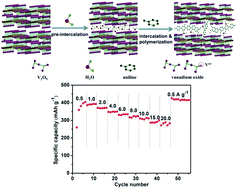A conjugated polyaniline and water co-intercalation strategy boosting zinc-ion storage performances for rose-like vanadium oxide architectures†
Abstract
The regulation of the interlayer spacing and microstructure holds particular promise for achieving boosted zinc ion storage properties for low cost vanadium oxides. In this study, we describe a proof-of-concept demonstration of a conjugated polymer and water co-intercalation strategy to drastically improve the zinc ion diffusion kinetics in a rose-like vanadium oxide architecture. Intercalating the conjugated conductive guest polymer not only intrinsically induces the electron transfer to lower the valence state of vanadium and thus improve the electronic conductivity, but also expands the galleries for efficient zinc-ion intercalation. The structural water also effectively shields the bivalence zinc ions, leading to reduced electrostatic interaction with V2O5 hosts and a higher diffusion coefficient. The electrochemical results show that the rose-like polyaniline-intercalated vanadium oxide architectures display unprecedented zinc-ion storage performances, outperforming most of the guest ion/small molecule-intercalated vanadium-based compounds. Our findings open an avenue to tune the electronic structure, interlayer spacing and microstructure towards advanced energy storage applications.



 Please wait while we load your content...
Please wait while we load your content...